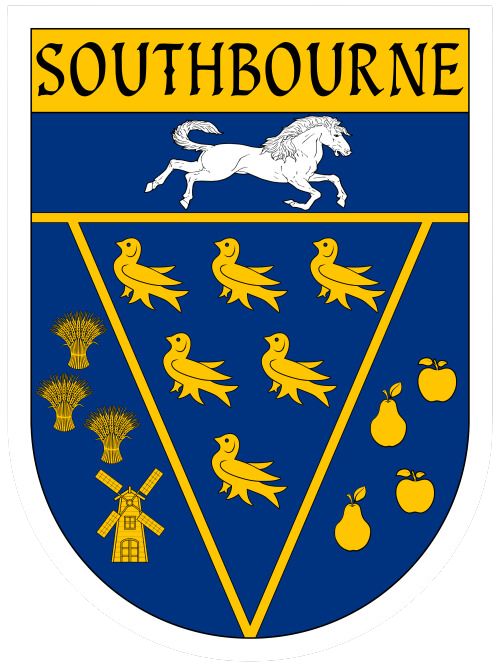The Story of The Free Church by Mr Freeman
The Story of the Free Church written by W.H. Freeman 1990
Our story of the Church begins in the year 1855 when a number of Christians from Emsworth came to a small village called Prinsted to open a Church to the glory of God. For about fifty years they worshipped in a portion of a barn which was kindly lent at a nominal rental by a godly merchant and shipowner. The good work of the Church was established by him and continued with varying success in the years after his passing away.
The barn, which was lent by Mr Elijah Packer, measured only 15ft by 20ft, yet in it met a Sunday School with an average attendance of about 50 children, and a Sunday evening congregation of about 60.
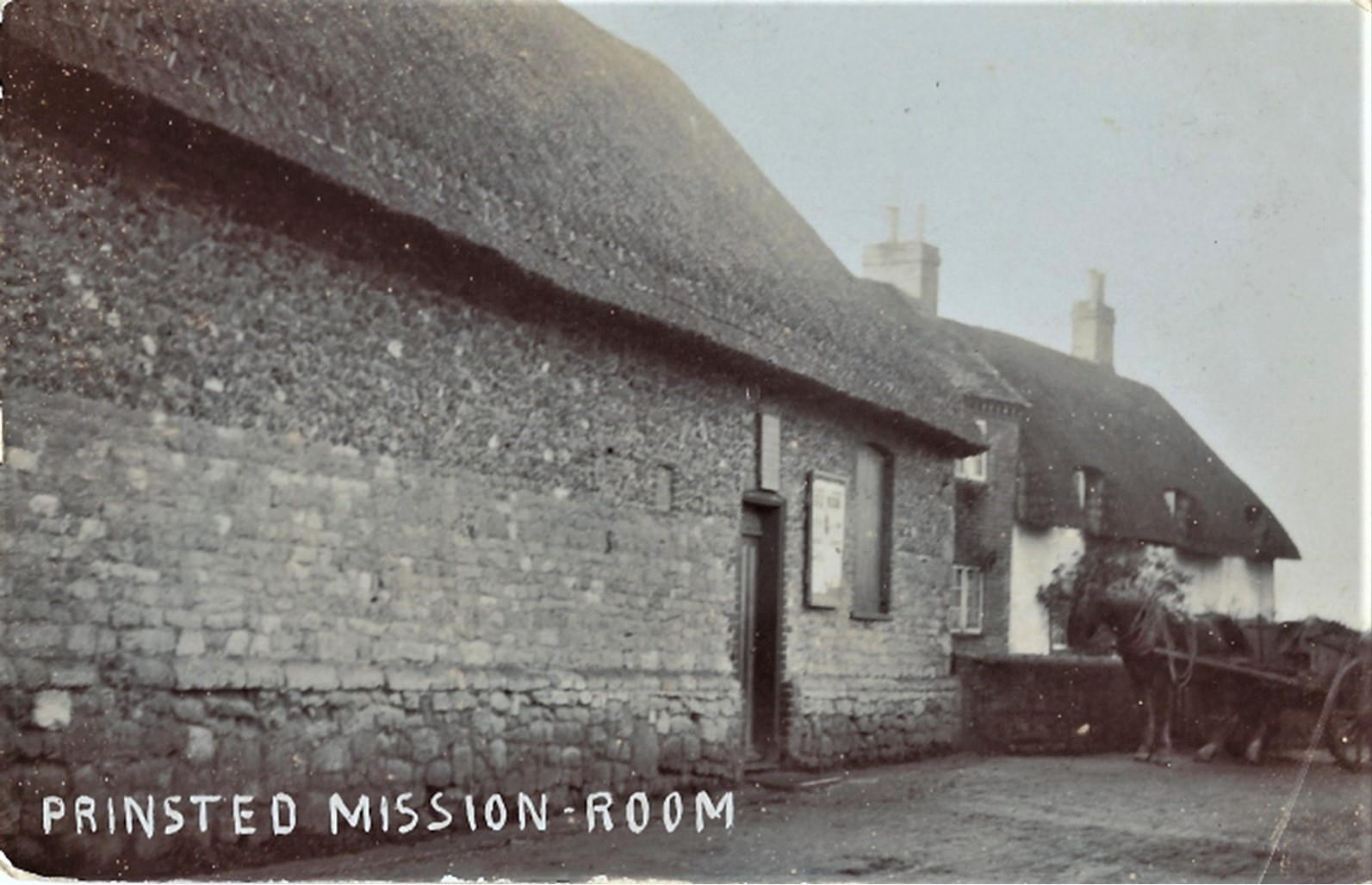
Near to the Prinsted Meeting room in the barn, there had sprung up during the latter part of the eighteen hundreds, a new residential district known by the name of Southbourne, located on the Emsworth to Chichester main road. Because of the religious need of the population of this rising neighbourhood, which was continually increasing, they felt that God was calling them to think about a move from the barn at Prinsted and to open up at Southbourne.
The people who worshipped at Prinsted, realised for a long time, the need not only for a suitable building in which to worship God but also the lack of opportunity to reach those around them who would like to worship with them and aid the spreading of the glorious gospel of Jesus Christ. To remedy this, our friends set themselves to work with a holy enthusiasm and so in the year 1907, they ventured to purchase a site in The Drive, Southbourne, with the intention of one day erecting a new building which would serve the people for many years to come.
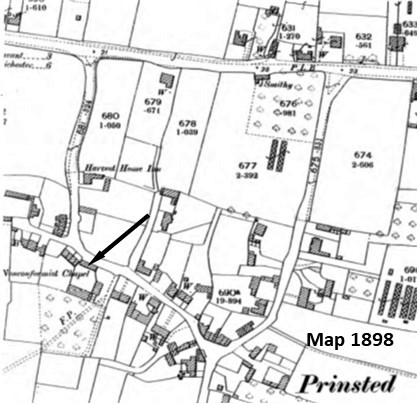
Although they had purchased the site they had no immediate prospect of utilising it by the erection of a permanent building, but that did not dampen their burning desire to preach the gospel to the people of Southbourne. So, they erected a tent and held tent meetings there, having faith to believe that God would provide them with a permanent building in which to worship.
Quite unexpectedly they heard that in the neighbouring town of Portsmouth, an iron Church was about to become disused and awaited a purchaser. This news was conveyed to the Trustees of the new site, who resolved to make a contract for the purchase and re-erection of this building which had only been used for about 6 years. The building itself was in a good state of repair and could accommodate between 300 and 400 persons. There was also a suitable vestry and altogether it seemed a most desirable investment, and certainly a wonderful answer to prayer.
The purchase of the land cost £75. The contract for the purchase and erection of the building and fencing £270. The furnishing of the building for worship with chairs and other necessary furniture £50. The members of the church at Prinsted had already raised £40 without making any public appeal; with the opening services to be held in the Spring of 1908, it was thought to be able to raise another £35 thus leaving £320 to be provided. They said that it was very desirable that an infant Church like this should be started without a heavy debt, thus a letter was sent out to interested parties signed by William S. Wyle, Pastor of the Zion Baptist Church.
It is interesting to note the names of those men who were behind this purchase of the Iron Church. Men such as Ernest Cox of Nutbourne, John Dyer, Frederick Veysey, George Davis and Archibald Davis of Emsworth.
Then there were those who wrote letters of support, such as one received from a G. Robert Hern of Lake Road Chapel, Portsmouth dated June 13th 1907. It said ‘The Baptist Church at Emsworth under the guidance of the Pastor and with the consent of the Officers, is making a very laudable attempt to sustain the work and to build up a cause at Southbourne. I can, knowing Mr. Wyle, heartily commend his work to those concerned.’
Another letter dated 12th June 1907 from a Mr. John Kemp said, ‘I gladly recommend to the favourable consideration of all lovers of evangelical religion the effort that is now being made by my friend Mr. W. Wyle and the Baptist Church at Emsworth to erect a worthy building for worship at Southbourne. The development of Southbourne Park Estate and the building of a new station by the L.B. & S.C. Railway, makes the provision of the new Chapel an urgent necessity. I am thankful that Mr. Wyle is taking the matter up so warmly and trust he may meet with complete and speedy success.’
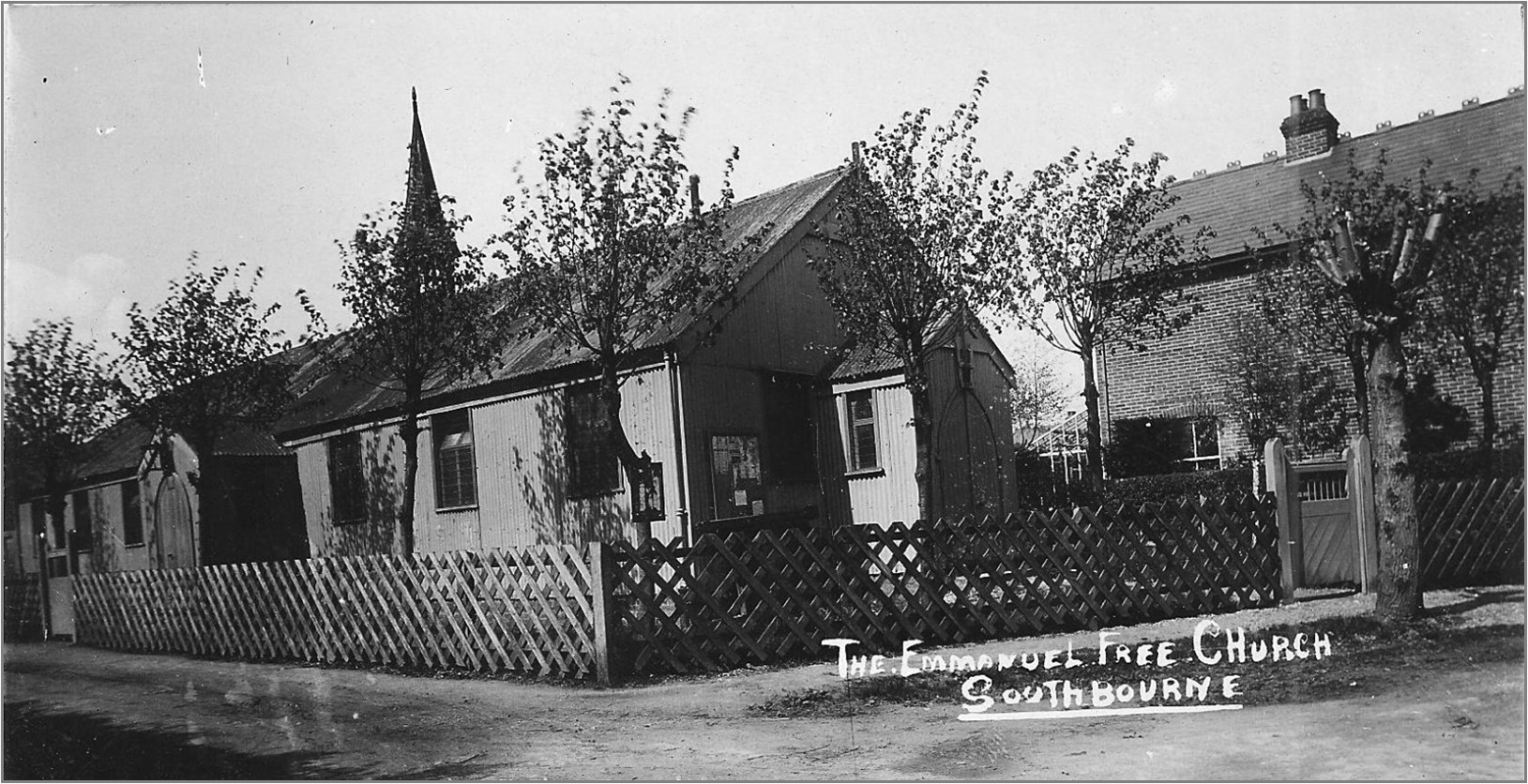
So it was that the Iron Church was duly erected and made ready for worship. The first service held in it, took place on March 26th 1908. Records state that the services were a great success and were able to announce that the Rev. C. Trim Johnson, a retired Baptist Minister, had taken up residence in Southbourne and that he had accepted the invitation to become Superintendent of the Church. This was indeed a wonderful answer to prayer. The debt now upon the premises in 1908 was £450. The Baptists Union Building Fund kindly lent £150 free of interest, which was a great boon to them at that time.
In the Spring of 1913 it was brought to light for the first time that provision was made for the formation of an Evangelical Free Church. Members of the Church were asked for their opinions and as a result of this special services were held on Sunday 29th June 1913. The minutes of that meeting record that indeed it was a Red Letter day. No one who was privileged to share in the services will ever forget it.’
A prayer meeting was held at seven o’clock in the morning at which many blessings were received. The 11 o’clock morning service was well attended. Mr. John Palmer spoke on “A new commandment I give unto you, that ye love one another as I have loved you.” In the evening meeting, Pastor John Kemp spoke to a good congregation “That in all things He might have the pre-eminence.” Then followed the formation of the Church by Mr. Kemp and the solemn covenant was read which is as follows:
SOLEMN COVENANT ADOPTED JUNE 29th 1913
We, a Company of Believers in the Lord Jesus Christ, are this day met to
form ourselves into an Evangelical Free Church and to enter freely into
a Solemn Covenant with God and one another.
We do this day avow God to be our Father through faith in Christ Jesus.
We anew commit ourselves to the Lord Jesus Christ as our only Saviour,
our Prophet, Priest and King; and we do yield ourselves to the Holy Spirit,
our Sanctifier, Teacher and Comforter, whose gracious operations
we desire daily more and more to experience and enjoy.
We unfeignedly accept the Holy Scriptures as a complete revelation
from God for the means of Salvation from sin, and the sole and
final authority upon all questions of Christian faith, duty and conduct -
and we do now solemnly unite ourselves together as a Christian Church
to maintain the worship of Almighty God,
to promote the diffusion of the Gospel,
to seek the Salvation of our fellowmen and
to build up one another in our most Holy Faith;
and we will always strive as grace is given us to walk in all
the commandments and ordinances of the Lord blameless.
This Covenant, God being our helper, it is our purpose sincerely
and loyally to keep, in proof of which we do solemnly
subscribe our name hereto.
(All present signed their names).
The Lord’s Supper was then partaken, a number of friends joining with the newly formed Church. At this service, a thank offering was taken which amounted to £3.16s.6d. The meeting closed with singing “Praise God from whom all blessings flow.”
The Lord continued to bless the work of the church under the guidance of the Ref. C. Trim Johnson. During the war years of 1914 to 1918, the Church debt was paid off and a fund started to provide coal for the women whose husbands had gone to the war. Ladies formed themselves into sewing parties to make comforts for the men at the front line.
On January 22nd 1919 a letter from Rev. C. Trim Johnson stated that ‘For ten years it has been my privilege to serve this cause as its Honorary Superintendent. No one is so conscious as myself of failure, mistakes and shortcomings, but thank God I love Jesus Christ my Lord and Saviour. I love His Church and I am sought to help in His work…. I have not to my knowledge injured anyone in any way. If I have done so unknowingly, I am sorry and humbly crave their forgiveness.
I beg you dear friends to be united, rally round your leaders. Do not expect perfection in anyone, unless it be yourself. Do your best always for the Lord’s work and be determined by God’s help that our Church, dear to all our hearts, shall be increasing in power for good and blessing to this district… may the Holy Spirit rest upon and abide with all our fellowship always.’ Signed C. Trim Johnson.
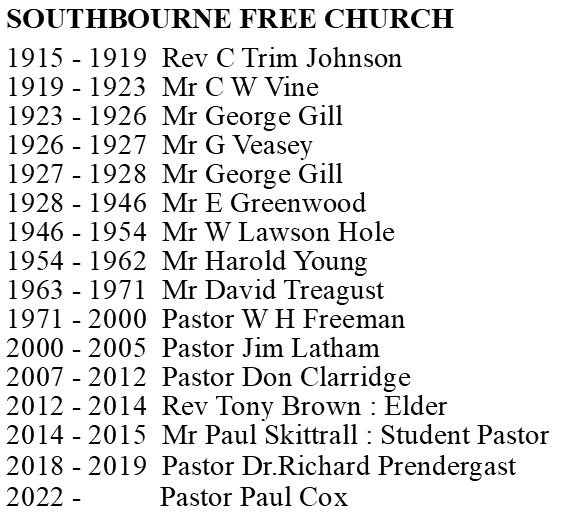
This meant that the vacancy had to be filled. Much prayer was made to God to provide a Superintendent or Chairman to run the Church. Mr. C.W. Vine was duly appointed and remained in that office until his retirement on the 31 January 1923. During his office a Trust Committee was formed and the Trust Deeds of the Church were amended. The Church continued to receive the blessings of the Lord.
Mr. George Gill accepted the position of Chairman of the Church but withdrew on January 27th 1926 in favour of Mr. Vessey who served for a short period until January 27th 1927. The Church then appointed Mr. E. Greenwood, who served the Church well until his retirement in 1946. During his term of office, the Church had a membership of 71 and a Sunday School, under the leadership of Mrs. Worrall of 85 children. Activities of the Church were Band of Hope, Christian Endeavour and Sisterhood. Picking out some of the ’High Spots’ in the various minutes we note there were 80 names on the books of the Sisterhood, Christian Endeavour over 30 and the Sunday School continued to be well attended.
Mr. E. Greenwood called a special meeting which was held on May 19th 1931. This meeting was called to receive the reports of the Committee concerning the negotiations with the Baptist Union. The Secretary stated that the Baptist Union refused to sell the buildings and that the Baptist Union had referred the matter of the revision of the Trust Deeds to the Southern Baptist Union. So it was decided ‘that the members would continue to function as a Free Church in the present building and that a building fund be started at once to raise money to build a new Church as soon as possible. Should the Baptist Union refuse to amend the Trust Deeds, so that our views may both be met for the new Church to be built on the existing site, and a new site would be purchased.’
As a result of this, a special meeting was held on Wednesday, February 15th 1933. A letter received from the Baptist Union was discussed because for the last three years every endeavour had been made to persuade the Baptist Union to sell the Church building to the members of the Free Church. At their request, an offer of £280 was made, at the same time, reminding them of the £150 we had borrowed and had paid back. In their reply the Baptist Union said they were willing to accept the offer.
The Church then agreed to the following resolution - that the Trustees be empowered to buy the land and buildings known as Southbourne Free Church for the sum of £280. This was duly done so that the site and the Church building passed into the care of the Trustees of the Church. This indeed was another milestone passed in the history of the Church.
Various repairs were carried out during the next few years on the building and at each Annual General Meeting, thanks were expressed to those whose faithful service kept the Church as a witness in the district of Southbourne. In 1946 the tin roof and the woodwork were painted and the notice boards repaired, but the ironwork on the outside of the Church was not painted.
On the 17th September 1946 Mr. Greenwood felt that the Presidency should be undertaken by a younger man and it was proposed that Mr. W Lawson Hole be asked to fill the vacancy, which he accepted. He expressed a wish to form a Boys Brigade but this venture did not transpire. Perhaps this was because there was already in the Church a Girls Guide company and a Young Peoples’ Club. It is good to know that there were 110 children in the Sunday School in 1946.
At the Annual General Meeting on the 8th June 1951, Mr Lawson Hole said there was continued apathy in all areas and remarked that a number of people went out of the village to attend other places of worship, thereby doing the Church a grave disservice.
From time to time, the question arose that a full time Pastor be appointed to take control of the spiritual life of the Church. Mr. C. Lummus was suggested but it was felt that his personal beliefs, might not allow his being able to follow completely the lines of thought and teaching required by the Church. How wrong these people were, because this dear godly brother proved to be a source of spiritual comfort in future years to the Southbourne Free Church. Those who had the pleasure to know him and to work with him thank God for every remembrance of him. Now he is with the Lord whom he loved so much.
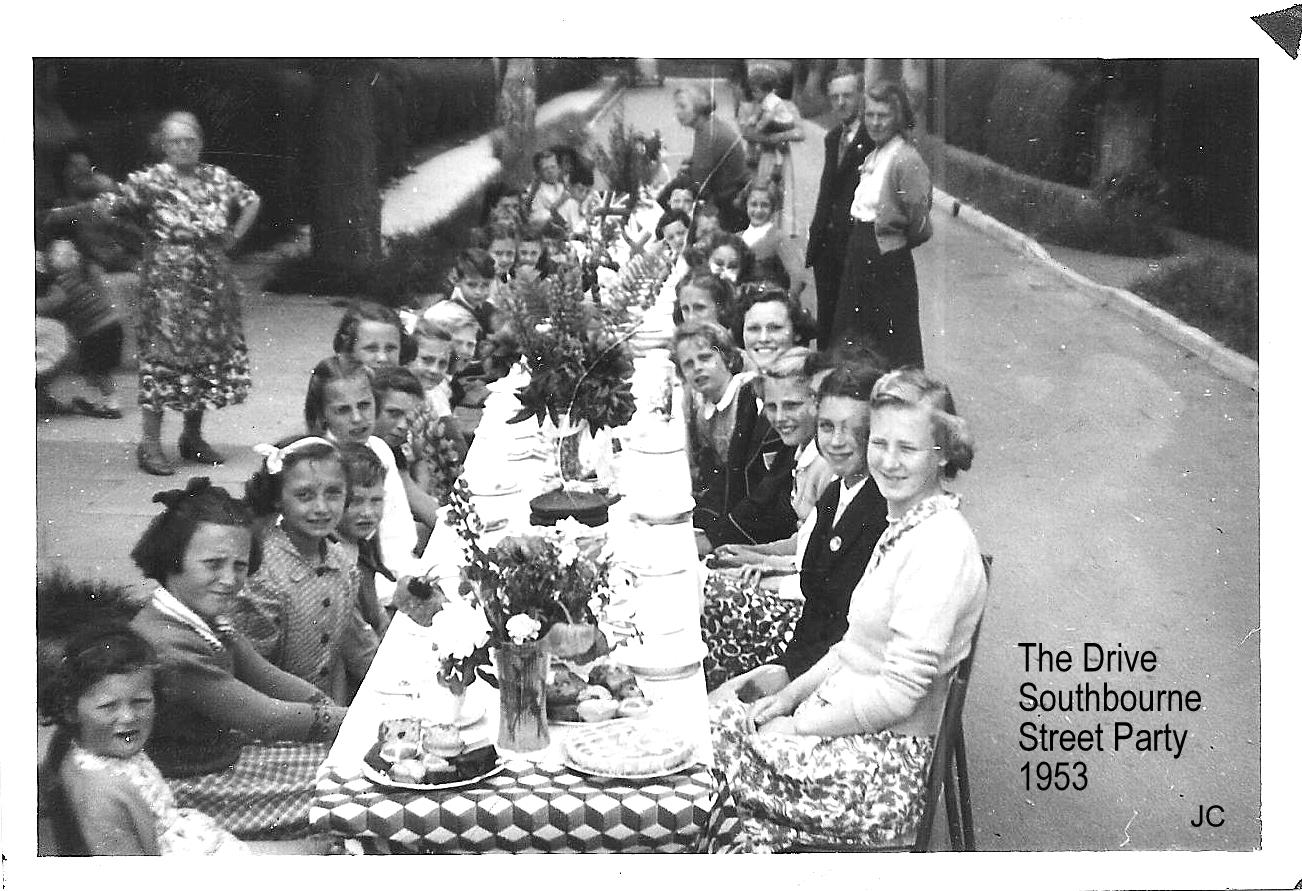
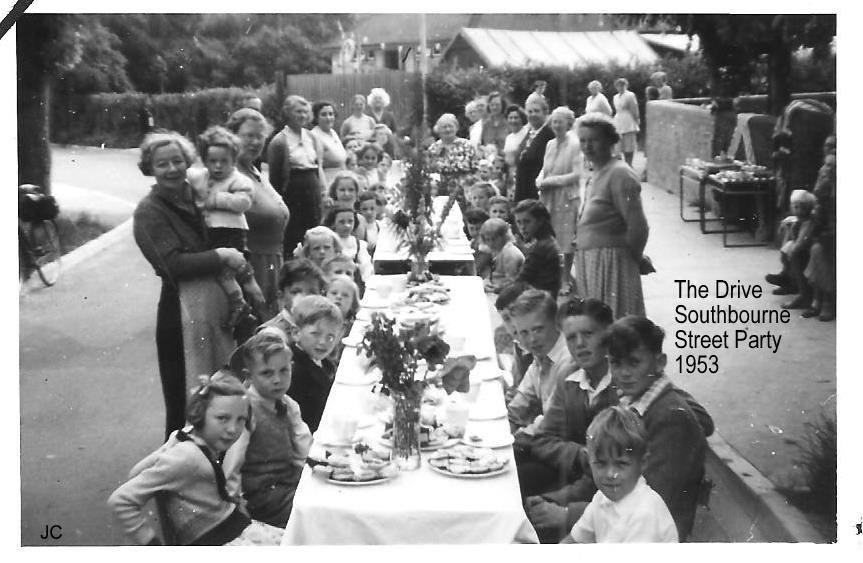
On the 19th March 1954, the President, Mr. W. Lawson Hole said that owing to circumstances his work as President would have to come to an end. He felt a younger man should now take charge. He told the members that he had approached a Mr. Young to get his views on coming amongst us. Mr. Young said he would come with great joy and felt there was an open door for him at Southbourne. The Church wanted to present Mr. W. Lawson Hole with a cheque as an appreciation of his work, but he said that whatever sum they gave him he would return it to the Church, and he did.
So Mr. Harold Young was appointed in 1954 as President and in 1955 the Sunday School reported that they had 41 children in attendance. The Sisterhood said that numbers had increased. The Youth Club membership was 19 and the Sunshine Corner had 90 children in the register. This was the centenary year of the Church, a far cry from the days when the meetings were held in the barn at Prinsted! Mr. Young went on to say that he tried, with God’s help, to carry out the vows he made to the Church on his election. He further said five people had accepted Christ as Saviour, seven had been baptised and six new members had been added to the membership roll. Truly this was a centenary year to remember, but at the same time giving God the glory.
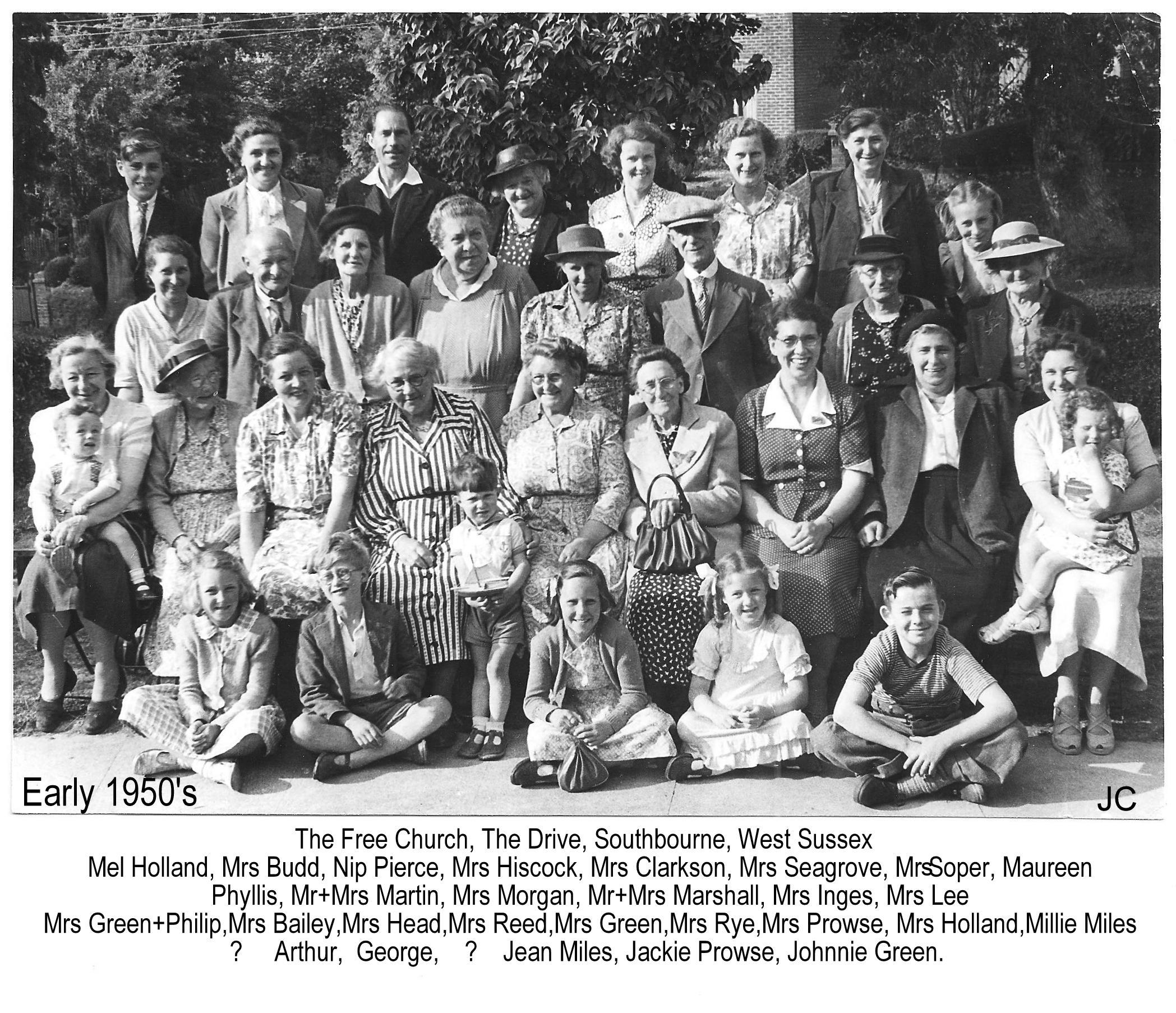
Difficulties and problems came and went during the next few years in the story of the Church. One thing was certain, however, the Gospel was still being preached in the power of the Spirit of God. The light was still shining forth from the Southbourne Evangelical Free Church.
The local school had been using the Church Hall as a classroom and many grown-up children remember that it was in the Southbourne Free Church that they learnt their three ‘Rs’. There is now in Southbourne a Village Hall but it was the Free Church who first suggested a Village Hall and started a fund towards bringing it to pass.
Now let us return to the passing years of the Free Church.
People complained about the gas fires, the outside toilets and even that the spirit of discontent was causing members to leave, but the undercurrent ceased and the people were soon praising God for all His goodness. New gas heaters had been installed, the vestry decorated and a new doormat was purchased. The gas ring was now giving trouble and the gas copper was leaking and the organ needed attention etc. Yet, all these problems were solved.
Many wonderful people faithfully laboured in the work of the Church, far too many to name them individually. However, one name must have mention here I refer to Mr. David Treagust who was Vice-President in 1962. He had come up through the Sunday School and now was about to play a major part in the future of the Southbourne Free Church. In January of that year Mr. Young resigned from being President and that meant that the Vice-President Mr. David Treagust had to take full control of the work of the Church. It was he who started the Building Fund for it was then thought that a new building would soon have to replace the old.
Mrs. D. Treagust said in 1966 that the Church Leadership had now appeared on all Committee Meetings and three Annual Meetings. Four gentlemen had been contacted. Three of these had drawn a blank, but Mr. Whyler from Leeds had been in the area for five days, visiting members and taking the Sunday Services. On approaching members of the Church, Mr. Treagust went on to say that he had found they were divided in opinions, and after much discussion, it was thought that Mr. Whyler would not be a suitable leader. So, he said, we will continue to wait upon the Lord and pray earnestly that God would send us the man of His choice. At the same meeting Mrs. Treagust, now in charge of the Sunday School, said that the average attendance was 50 and that she was sad to say ‘Goodbye’ to Mrs. Shakespeare who had been such a faithful worker in the Sunday School.
So the prayers and search for a Church Leader continued. A Rev. Durrant visited the Church in 1967 but after careful consideration, it was felt he would not meet our need. During that year the need was again stressed that the structure of the Church would not last much longer and that even greater efforts should be made to increase the Building Fund.
The work as President of the Church was now being undertaken by Mr. D. Treagust who found it very difficult at times because of his everyday commitments. Yet in spite, of this he faithfully served as leader of the Church. The Building Fund in 1969 had now reached the total of £2,622 and the search for a pastor continued. The Rev. D. Thomas was approached about becoming the possible Pastor of the Church but there being no unanimous decision, further guidance was being sought. The Church had by this time become a member of the Fellowship of Independent Evangelical Churches known as F.I.E.C., which proved to be a blessing in the years to come.
Future plans were discussed on May 21st 1970 and approval sought for the selling of the piece of land at the rear of the Church. The amount from the sale plus the Building Fund of £2,950 would hasten the day for the new Church to be built. Some people were hesitant about such a move and felt it would be best to further wait upon God, which they did. However, the matter was again raised at a special meeting on November 3rd 1970. Mr. Treagust pointed out that the Building Fund had reached £3,300 and what with the sale of the ground at the rear of the Church the new building was now more than a possibility, but again agreement could not be reached. Mr. Treagust had invited others to this meeting among whom was a Pastor Freeman, little did he know what God had in store for him in the immediate future!
Mr. Treagust told a committee meeting on Friday 16th July 1971 that he had been in touch with Pastor Freeman concerning the pastorate of the Church. Mr. Freeman had been all his life in the work of the Lord and for the past seven years had been Pastor of the Pentecostal Church in Croydon.
Being out of work he had got a job as a postman in Emsworth Post Office.
While delivering letters on the second delivery early in July 1971 he heard God speak to him saying “You know all about the troubles in Southbourne Free Church, don’t you?” To which he replied “Yes”. Then the voice spoke again and said, “With all your experience you have the know how to put it right.” He answered “I suppose so.” Then the voice spoke the third time and said, “Then what are you going to do about it?”
As Mr. Freeman said, God left the choice to him, it would have been easier if he had said “Go”. Well, our brother did take up the pastorship of the Church and was duly inducted on Wednesday 29th September 1971 by the Rev. D. Cox of Eastney Evangelical Free Church.
Mr. Freeman had building experience and it was not long before all the trees around the Church were cut down to let in more light. All the windows were protected by wire screens to save damage to the glass by children. He said we can trust God to look after the windows and so the screens were removed. He asked that consideration be given for a baptistry to be made in the Church, as it was part of Christian worship.
The Building Fund was now £3,800 and several brochures on new buildings were looked at with an eye to the future This was purely speculative because no decision could be taken without a full Church meeting.
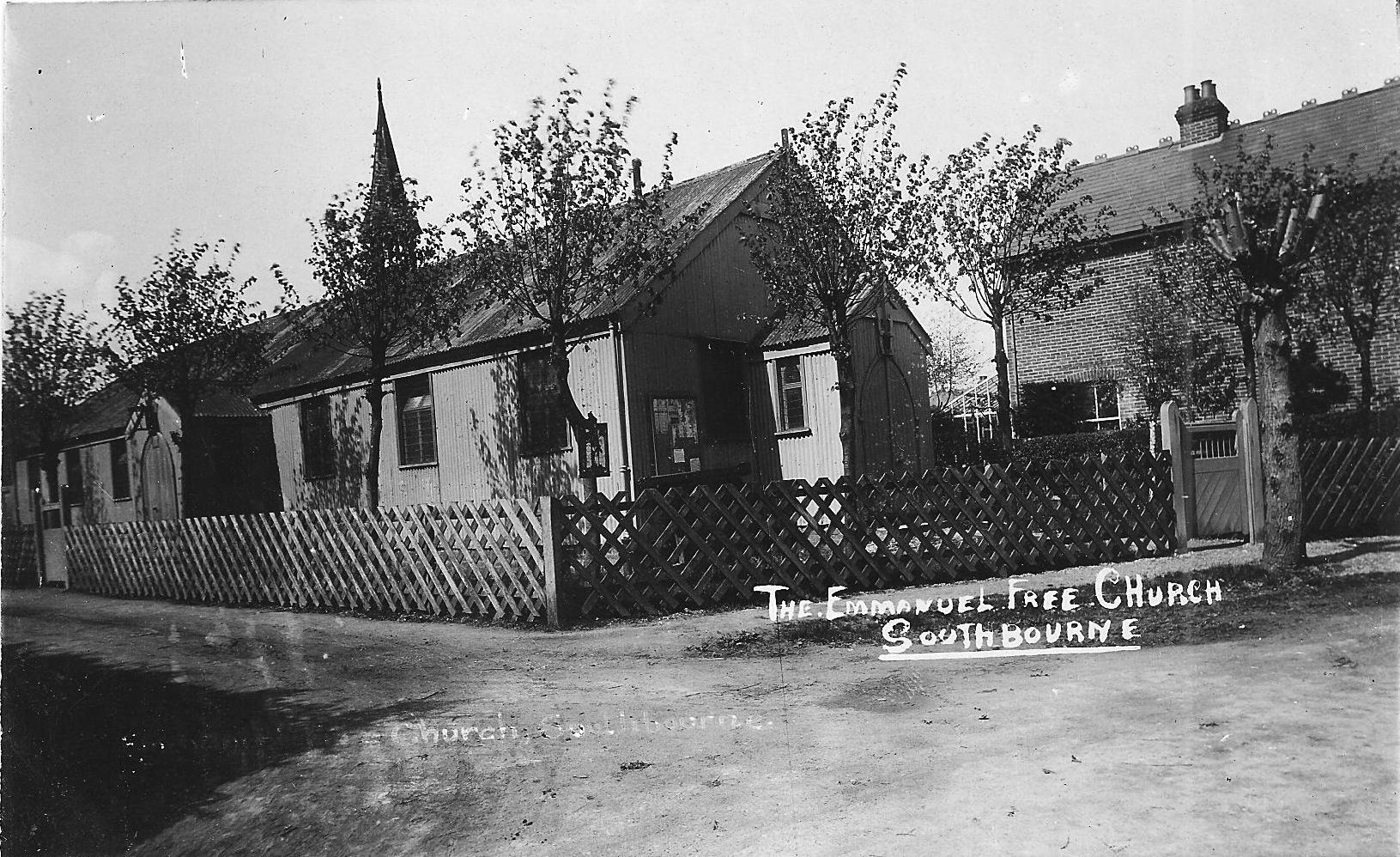
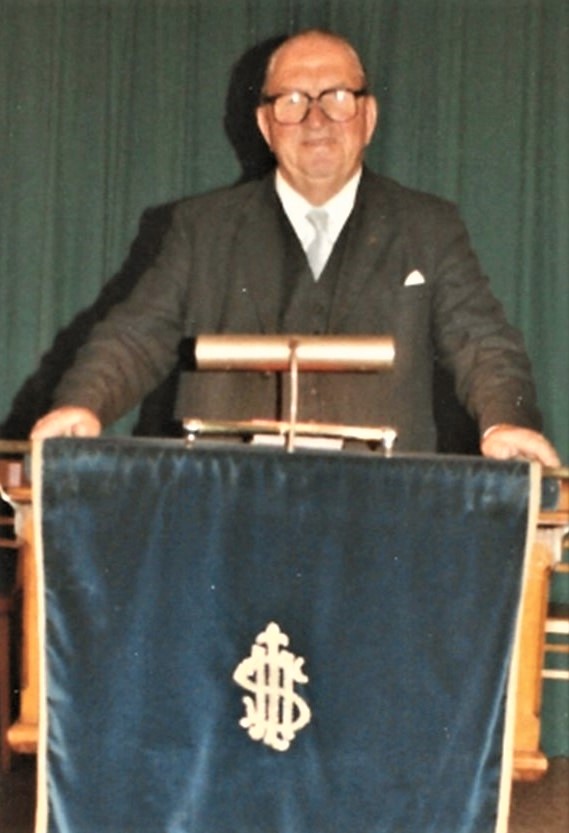
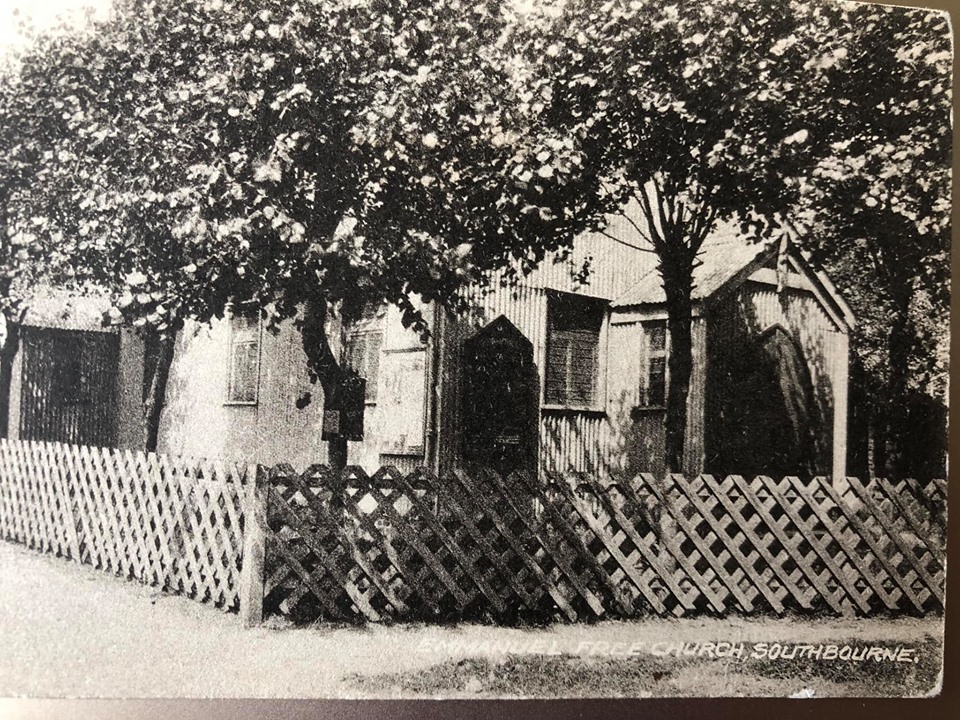
before the removal of the trees in 1971
In October 1973 the Pastor had a strong feeling that he had not only been brought into this Church for spiritual matters, but also for a material reason. We have mentioned before that the Pastor had practical knowledge of building construction. So our Pastor believed that God wanted him to refurbish the old tin Church and he asked God for help to do this. His faith was rewarded for all the money came in without a penny being asked for. Something like £18,000 worth of work was carried out.
The first task was to make sure that the woodworm, clearly seen in the interior match boarding of the Church, had not gone through to the main structure. To do this, we lifted several lengths of the corrugated sheeting on the outside to reveal the main timber. There was no sign of any woodworm to be seen. We also found the timber to be so hard that it was with difficulty that we were able to knock a nail in. Then we had a moisture test put on the timber to test for wood rot, and the needle on the instrument stayed at nought. This meant that the whole of the structure of the Church was solid and free from rot. Next, we tested the damp-proof course throughout the whole building. We found that it had a slate damp-proof course. Whiteheads of Chichester surveyed the entire structure and pronounced it sound and worth refurbishing. Thus plans were drawn up for the work to proceed.
It was on Friday, 8th February 1974 when Mr. Freeman presented the plans to the committee for discussion. These plans were for recladding the outside walls, re-roofing, building new toilet facilities, schoolroom and vestry. After much discussion, the committee unanimously agreed to seek planning permission to carry out this work. This then would be put before the full Church membership as an alternative to building a new Church. So it was agreed that a public meeting be called, inviting by letter, members and friends who over the years had contributed to the Building Fund.
The public meeting took place on Thursday, 25th April 1974. Mr, Freeman welcomed all present and outlined what he wanted to do with the building. The feeling of the meeting was unanimous that plans to reclad be brought forward and voted on at the next A.G.M. which was soon to take place. Men with building experience came forward at the public meeting and offered to give their services free of charge.
One man said, here are my hands Mr. Freeman please use them. He did this and turned out to be a very good carpenter.
A building committee was formed, namely Mr. Brunnen, Mr. Stark, Mr. Newell, Mr. Taylor, Mr. Cobden and Mrs. Howard. The Pastor was the Chairman.
The approval for the work to go forward was given at the Annual General Meeting on the 17th May 1974. Mr. Freeman said that with £4,859 in the Building Fund, it was not wise to delay any longer as building costs rose weekly. He detailed his plan of campaign to the meeting and stated he was prepared to commence work immediately if approval was given. Mr. Stark proposed that approval be given for the work to go forward. This was seconded by Mr. Treagust and carried unanimously. At this point, Mr. Freeman expressed his sincere thanks to Mr. Treagust for his hard work and vision over the years in controlling the increase and use of the Building Fund. He said that without this effort by Mr. Treagust there would be no money to spend on this project.
So the work was put into top gear. The Pastor was still working at the Post Office rising at 4.15 a.m. doing his deliveries. Then at midday, he went straight to the Church to work until nine and ten at night.
In October 1974 he reported that the work was progressing satisfactorily despite the inclement weather and he had high hopes of completing the new toilet and kitchen facilities for Christmas.
The roof had been completed, much of the work on the porch done, new front steps, floors were laid in the kitchen and vestry and the toilet walls would soon be plastered.
The Church had purchased toilet bowls, concrete posts and for the front porch, 2,000 cement blocks, 2 1/2 tons of cement; 4 tons of shingle, 3 tons of sand, 3,200 roof tiles and 2,400 bricks. All bills were paid for as soon they came in. It should be pointed out that the Council passed the plans within the month, with no alterations whatever this surely was a miracle.
One or two amusing stories happened during this rebuilding. The outside corrugated sheeting was taken off and expanding wire put in its place. This was to be coated with one inch rendering covered with Tyrolean. To do this was needed hair - usually horse-hair - to mix with the rendering causing it to bind and not crack. Horse hair was impossible to get in quantity. It was suggested that we could use strands of fibreglass; which incidentally, proved a complete success; but where could we get all that amount of fibreglass?
He went to a firm which made fibreglass boats and asked the price of fibreglass. He was told it was a pound in money for a pound in weight. The Pastor thought, ‘my word that is going to cost the earth’. ‘What do you want it for?’ the man said, he replied, ‘I only want to put in plaster.’ You should have seen the look on the man’s face, he thought he had met with a serious accident. After he further explained, the man said ‘come with me.’ He took him and showed him bags of offcuts and said ‘Will this do?’ ‘Just what I want, how much?’ said the Pastor. ‘Give me a pound for the lot.’ Only God could provide like this for He knew where the supply was to be found. Those bags turned out to meet all our needs and many thanks are due to the ladies who came along and teased the offcuts into strands to mix in the concrete.
We needed roof timbers, floor joists and floorboards. At Emsworth, a large shop and house were being demolished to make way for the new road. All the timber from the house and shop was in a pile on the site. Pastor saw the pile of wood and made a bid for it of £50 which was accepted. An interested person near the Church had a lorry and said he would pick up the timber and bring it all to the Church and there would be no charge. There was enough timber to meet all our needs of the reconstruction.
A plant hire person came to the Pastor and said anything he wanted from his plant he could use free of charge. He said, ‘I have got a new cement machine that is yours for as long as you want it.’ A lorry from another man was put at our disposal free of charge. When we dug the baptistry a man said if he could have the soil he would pay for the skip for us to use.
When the new toilet block was being constructed we needed a solid base on which to lay the concrete floor. A gentlemen who lives near the Church came and offered us a load of pebbles that he had over ordered. If we would like them he would give them to us, of course we accepted, so the solid base was made. A few months later this same man made the Church a new front notice board, which he gave to the Church.
We were given new furniture for the platform. A van came along and delivered three hat stands. Fifty new chairs were given for use in the Church Hall. We were also sent kitchen equipment. A few months later the electric wiring of the Church was renewed. New table and chairs in the vestry and many other things were received.
What with making a new school room, toilets, vestry and kitchen, we might have had one or two accidents, but we did not because God was looking after us even though such long hours were being put in. The Pastor had been laying concrete blocks along with Mr. Newell the bricklayer when he noticed all his finger tips were bleeding. This had been caused with so much handling of the concrete blocks. He said to the bricklayer, ‘What shall I do about my fingers Mr. Newell?’ Mr. Newell said ‘Wrap some adhesive tape round them.’ This he did and carried on laying the concrete blocks.
No cash was raised by appeals, jumble sales etc., for the Pastor believed that everything can be achieved by prayer. This is still the policy of the Church. As the bills came in the money was there to meet the bills. No one was kept waiting for payment. The baptistry was paid for even before it was built, for a pensioner saved up £100 which covered the cost.
Thus nearly two years of work was coming to an end, and an estimate of £18,000 was thought to cover the work we had already done. The money spent on the materials came to £6,712.64, and the Building Fund finally reached the sum of £6,841.75 leaving us with a balance of £129.11. Does this not prove that God fulfils His word to those who put their trust in Him?
The Chichester Observer and the Portsmouth Evening News wrote in October 1975 - “VILLAGERS BUILD THEMSELVES A BETTER CHURCH - their labour of love. Depressed by their tumble-down corrugated Iron Church, the Southbourne Free Church members decided on a do-it-yourself replacement. On Saturday the small team of dedicated toilers who have made the transformation possible will be showing villagers around, a service of dedication will follow”.
‘It has been a labour of love and has brought us a lot of happiness’, said the Pastor, Mr. William Freeman. ‘We have not begged or asked for a penny - it has all been done through faith. Most of the money has been given anonymously and the rest was in a Building Fund the Church has been providing for some time.’ said Mr. Freeman a 63 year old postman. ‘Materials and a small amount of specialist work have cost just under £6,000 and we estimate the job would have cost about £18,000 if it were done commercially,’ he added
Mr. Freeman had been toiling all his spare hours, assisted by seven men and six women, all volunteers. Some of them have been skilled tradesmen, but the others have happily turned their hand to cement missing, roofing and bricklaying.
Every scrap of corrugated iron has now disappeared, and the Church has a well insulated slate roof and concrete walls with the addition of a youth room, enlarged kitchen, new vestry and toilet block. Internal work on the Church Hall will continue when funds become available.
That the work has been done, and done well, within 18 months, is remarkable, but even more notable is the fact that much of it has been done by senior members of the Church, all over 60.
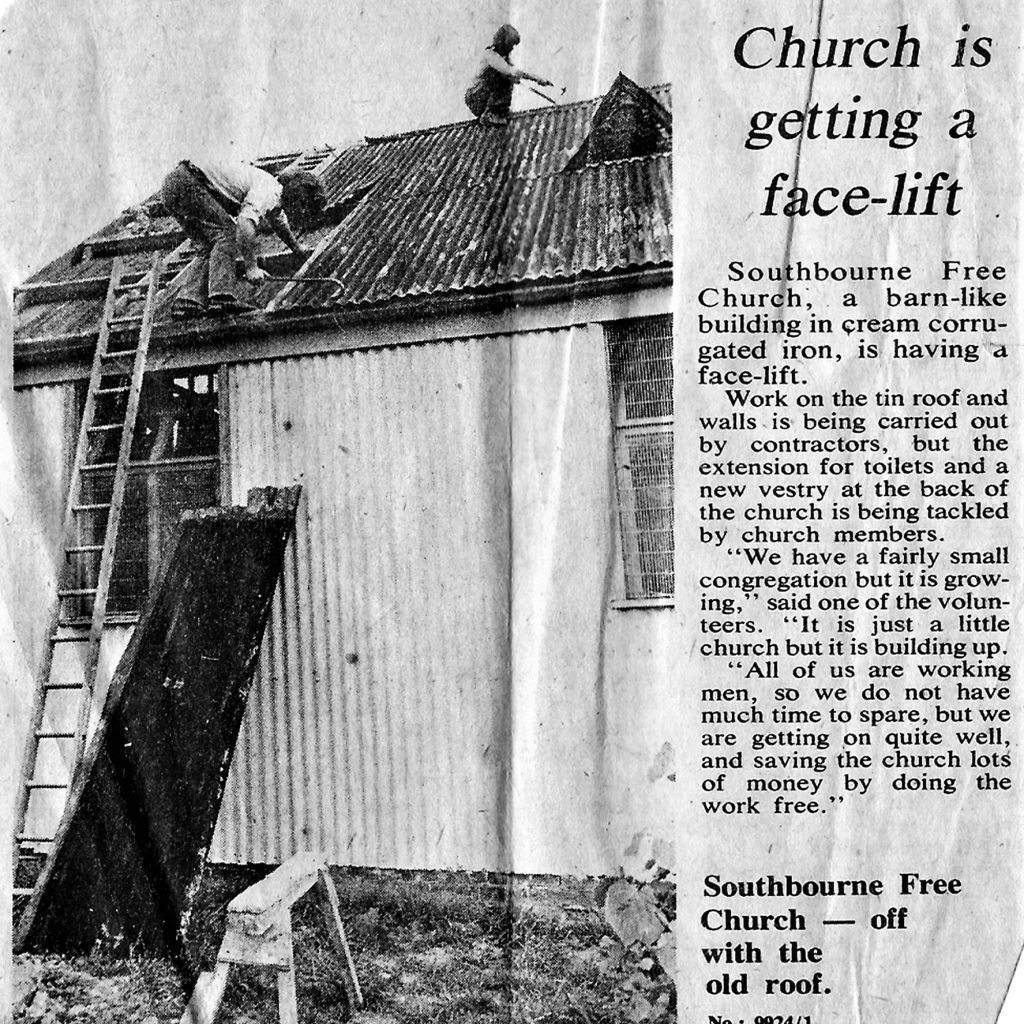
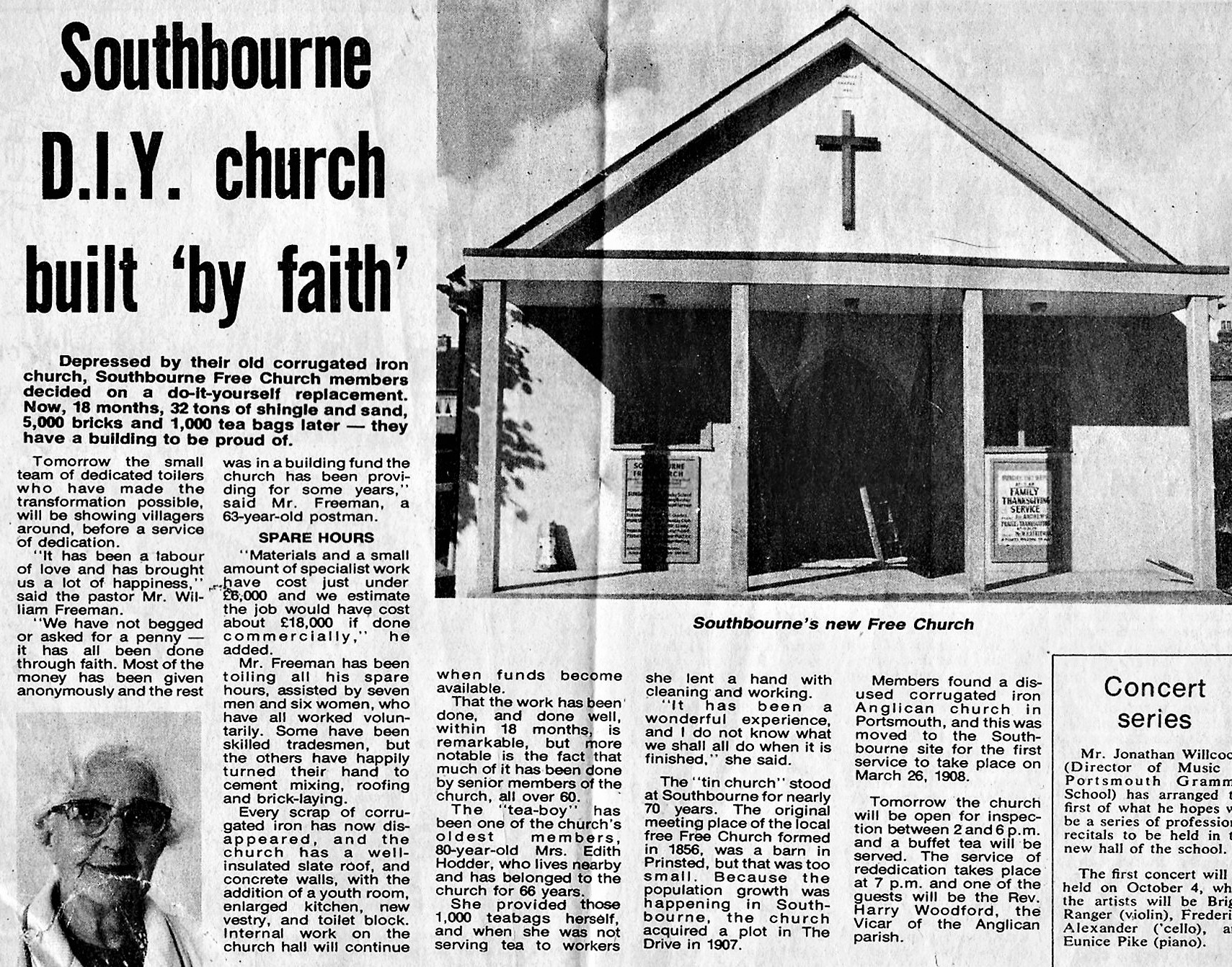
.
The “tea-boy” had been one of the Church’s oldest members, 80 year old Mrs. Edith Hodder who lived nearby and had belonged to the Church for 66 years. She provided 1,000 teabags herself. “It has been a wonderful experience, and I don’t know what we shall all do when it is finished”, she said.
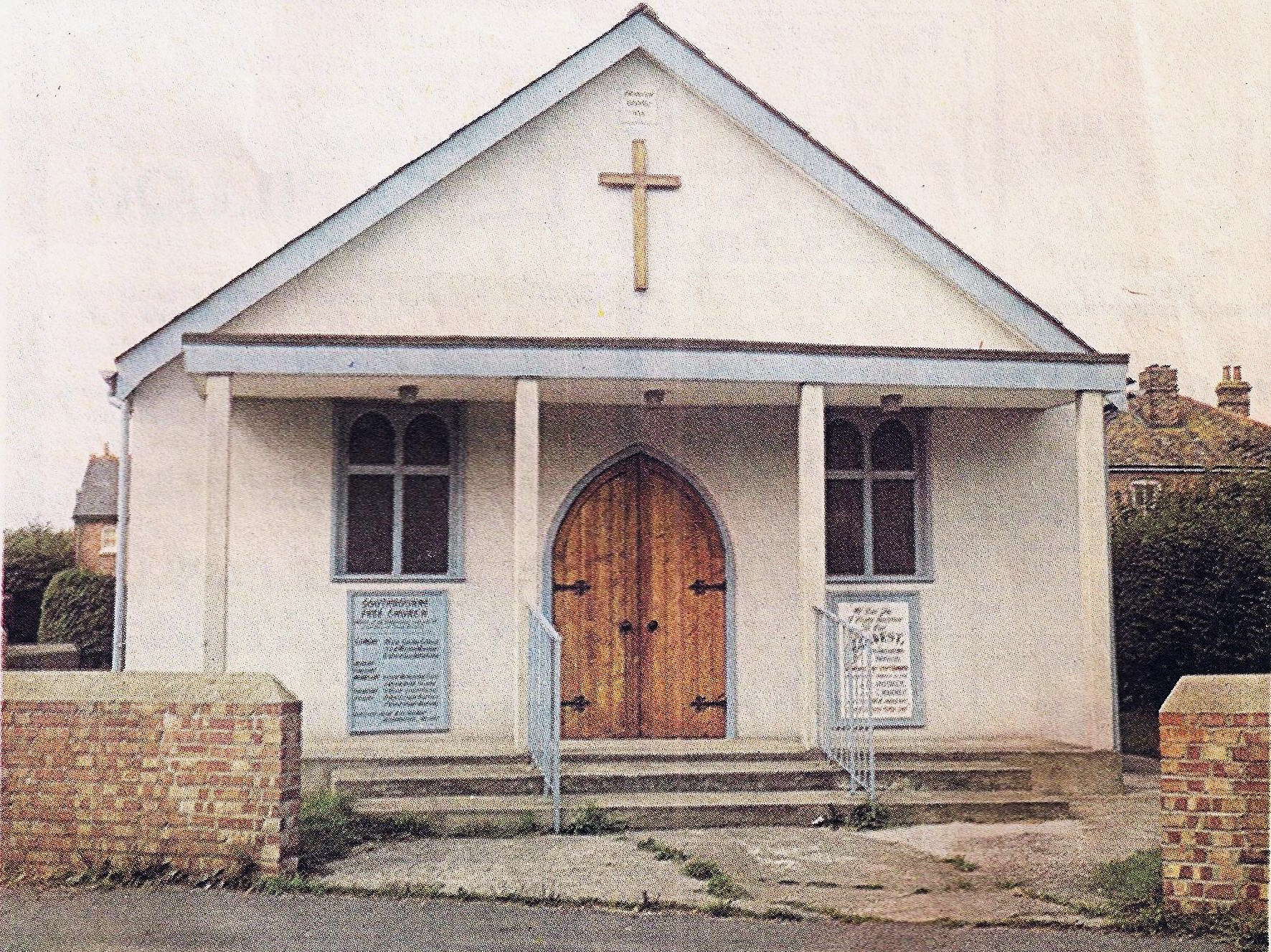
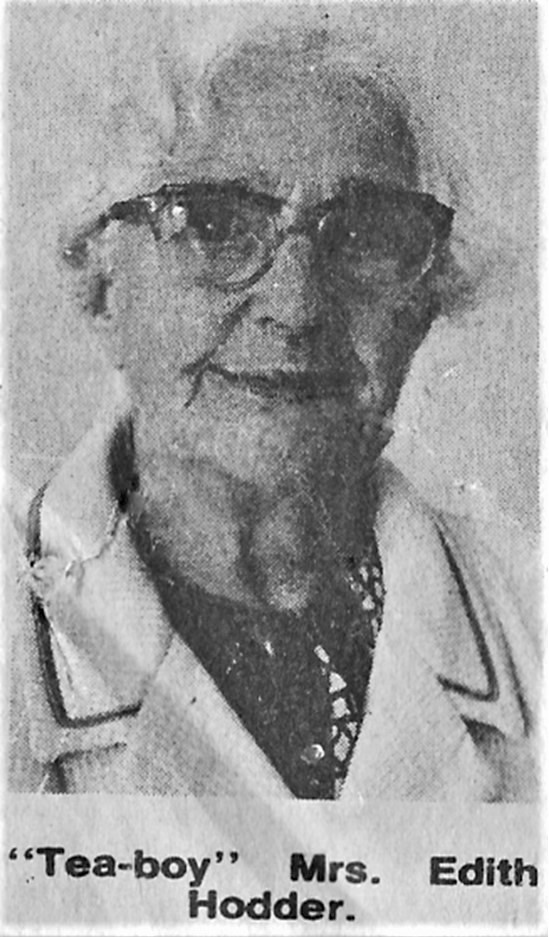
A special weekend Thanksgiving was held on 27th and 28th September 1975 when Mr. Gilbard and the Chairman ably conducted and addressed the 180 present. The Church was full to overflowing, the singing, musical items and preaching will always be remembered by those present. The meeting closed singing “Praise God from whom all blessings flow”. What else could they sing when all around could be seen the evidence of His great goodness to us.
There was a suggestion in May 1977 that a car park be made on the ground at the rear of the Church. Although this would be a great asset the money was not then available to construct a car park.
Through the Pastor’s connection with preaching at a Portsmouth meeting the baby grand piano they were using was offered to the Southbourne Free Church as a free gift which was accepted. This instrument tuned to the same pitch as the Hammond Organ greatly aids worship in the Church.
At the close of 1978 a man called at the Pastor’s home to show him a carpet square and asked if he was interested. He went on to explain that the local I.B.M. offices were changing the almost new carpet squares in their dining room at the factory. As he was in charge he asked I.B.M. if he could have them for the Southbourne Free Church if they had use for them. We gladly accepted them, with I.B.M. sending them up in their own lorry. They were given to us free and the number we had was sufficient to cover the Church, Vestry, new schoolroom and kitchen. God is good.
So the carpet squares were laid where before we had bare boards and now we had the money to buy new chairs for the Church. These arrived and were in use early is 1979. So the years rolled by as the work of God was carried on in the Church. The baptistry was in use, an outreach had taken place and every house in the district was visited.
Of course, there were other things we would have liked to have done inside the Church, but we had to wait God’s time. We needed a different form of heating in the Church because the fumes from the old gas fires were giving people headaches.
So our sights were set to install central heating.
Now our Church only has seating for one hundred people and we only have just over fifty members, none of whom are blessed with wealth. As we had said before, we do not hold jumble sales to raise money for God’s work, we believe in ‘everything by prayer’. So we told Jesus we would need £2,500. After telling members once, we left it to the Lord to supply. Slowly it came in, in the form of special gifts and donations put through the Pastor’s letter box. We then ordered the heating materials and when the invoice came for payment, yes, you are right, we had the exact money to pay for the same and not a pound over.
You need a first class plumber to install the heating and let me tell you how God provided for our need. A few years previously, a brother brought a coach load of deprived children to our Church so that they might have a fortnight’s holiday staying at our Church. This brother did not go to Church but during his stay with us felt the Lord was telling him to come into our district and worship at the Southbourne Free Church. Now, note how God moves. The same years that we bought the heating materials this brother moved down and became a member, he and his family. Now this brother is a first class plumber and electrician, so God provided materials and man so that His House could be put in order. We would like to say here, that in our Church we have men of every trade in the building profession, who given their skills free as unto the Lord.
So it was decided that after the Pastor came back from his holidays the plumber and he would install the heating in the first two weeks in February 1987 and would work all hours until the work was completed. But God had other plans, for the Pastor came back from holidays and was taken ill with heart trouble and was ordered to rest for two months. If you know our Pastor he never expects others to do what he himself is not prepared to do. So the men of the Church decided to get on with the work and tell Pastor nothing, if they came upon any snags as they said ’he will only want to come right away.’
The Pastor testifies that God allowed his illness to take place so that God might use others mightily. God is never without men and women who can carry on his work. Of course, the Pastor is now back in harness and enjoying the blessing of the Lord.
New floors meant new carpet squares and God told us just how to do it. Take the square from the Church and lay them in the Church Hall. We did and found that God did not make a mistake for we had the right number. Buy new ones for the Church, trust me go ahead. We had a sum of money in a car park fund which we could have used and repaid later on, but it was said it was money for the car park and must stay that way. However the bill for the carpet square came in for £1,200 and the money was here, waiting. Praise the Lord.
After a few weeks, we felt that God wanted us to make the car park at the rear of the Church. So we got an estimate which came to £1,850 and how much in the car park fund, £1,850. True we had VAT to pay on that, the final bill came to £2,175. The car park is now fully operational and has proved a great blessing.
The Pastor was on holiday at the beginning of 1988 and whilst he was away the Church Hall, schoolroom, kitchen and toilet block were decorated to a very high standard. The Pastor says it is a joy to work with men and women whose sole object is to please the Lord and not count the cost. The Church is being blessed in many ways not least in the spiritual life. One lady who had been in a mental home is now taking her place in society. A young lady of the church was wonderfully baptised with the Holy Spirit in her bedroom testifies that the bedroom was filled with the Glory of God. Christian men and women are being baptised and growing in the knowledge of the Lord. Much could be written about the spiritual life of the Church and the peoples’ love for the Word of God.
The men rallied around the plumber Mr. D. Ball who said the first job was to lift the floor boards. Suddenly there was a shout from brother Watson, whose foot had gone right through the floor, for it was rotten where he was standing. Other floorboards were then lifted and every one was rotten even the floor joists were rotten. ‘Let us try the Church Hall’, they said, and found it rotten as well.
Now all this was discovered on a Wednesday in February 1987 and a meeting of the Elders was called to make a decision. We shall have to put in complete new floors, but this is no good unless we build a cavity wall the whole length of the Church building. That night the Pastor rang to know if there were any snags, None that we cannot overcome, was the answer. So to tackle this huge problem the men of the Church took time off from work, others had their holiday, in all Thirteen men, beside the wonderful help of the ladies who did the labouring. Because it was thought that five or six weeks work was involved, Mr. Watson made arrangements for the Church to hold their Sunday Services at the Bourne Day School.
We do not know who will read this story of the Church but we want to tell you God performed a modern miracle in our midst, just as wonderful as when he fed the five thousand. The people had a mind to work as they laboured from dawn to dusk and Jesus blessed their efforts. Yes, yes, yes, they completed the job in three days and the services were held as usual in our own Church. Praise the Lord. More expense of course, but believing prayer brought the money in and the bill for £1,800 was paid!
When the doctor allowed the Pastor to come to an evening service, not knowing what had taken place, he was watched by those who had carried out the work and they said to him. ‘You should have seen your face when you looked around and saw what had been done’.
We are grateful that members of the Church, as a labour of love to their Lord and Saviour Jesus Christ,
undertake the cleaning of the Church, the grass cutting and hedge trimming and the general keeping of the premises. Hung up in the vestibule of the Church for all to see as they enter is the following - O Lord may the door of this house be wide enough to include all who need divine and human friendship. Narrow enough to shut out all envy, pride and strife. May its threshold be smooth enough to be no stumbling block to children or to straying feet, yet rugged enough to turn back the tempter’s power.
We pray that we shall always be able to live up to that, for the year is now 1990 and who knows when the Lord Jesus Christ will return. One thing is certain, that we in Southbourne Evangelical Free Church, will be working, waiting and watching for the coming of our Lord and Saviour Jesus Christ.
CROWN HIM WITH MANY CROWNS
